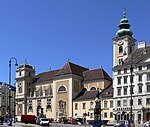Palais Porcia, Vienna
1546 establishments in the Habsburg monarchy16th-century establishments in AustriaBuildings and structures in Innere StadtEstablishments in the Archduchy of AustriaGovernment buildings in Austria ... and 4 more
Houses completed in 1546Libraries in ViennaPalaces in ViennaRenaissance architecture in Austria

Palais Porcia is a former urban residence in the western quarter of the Innere Stadt of Vienna, Austria. It stands at 23, Herrengasse between Palais Kinsky and Palais Trautmansdorff and across Palais Harrach. The palace was built in 1546 for the descendants of Count Gabriel von Salamanca-Ortenburg. It was representative of the simple Renaissance style that emerged in Vienna in the middle of the 16th century. In the 17th and later centuries it was extensively remodelled in Baroque and Rococo styles but the inner court still contains an early Renaissance arcade. As of 2010, Palais Porcia houses the Administrative Library of the Austrian Federal Chancellery.
Excerpt from the Wikipedia article Palais Porcia, Vienna (License: CC BY-SA 3.0, Authors, Images).Palais Porcia, Vienna
Herrengasse, Vienna Innere Stadt
Geographical coordinates (GPS) Address External links Nearby Places Show on map
Geographical coordinates (GPS)
| Latitude | Longitude |
|---|---|
| N 48.211388888889 ° | E 16.363888888889 ° |
Address
Palais Porcia
Herrengasse 23
1010 Vienna, Innere Stadt
Austria
Open on Google Maps










